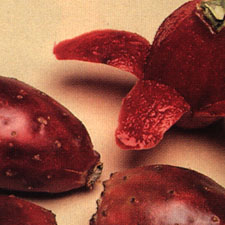
FoodFood InformationFruitTropical
The prickly pear is also called the cactus pear and the Indian fig. It
is actually neither a pear nor a fig but the fruit of a variety of cactus.
It originated in Mexico and was introduced in Spain by the returning explorers.
This unusual fruit is now grown, and even grows wild, in areas that border
the Mediterranean Sea. In the United States it is commercially grown in
limited quantities in California.
Depending on the variety, this pear or fig shaped fruit comes in many colors:
pale yellow, orange, pink magenta, and blood red. The latter color dominates
in the fruit grown in California. Although it is the product of a plant
that requires little moisture and thrives in very arid areas, the flesh
of the prickly pear is very juicy. The flavor is a refreshing combination
of tart and sweet.
The fruit is colorful, flavorful, and juicy, but it has two severe drawbacks:
The pulp is full of small, hard seeds and the outer skin is covered with
small, thin, very sharp barbs.
The prickly pear is one of our most seedy fruits. While it is claimed that
those seeds are edible, most people find them too hard to chew. Serve the
prickly pear as a fresh fruit. Cut off the top and bottom, slit it from
end to end, and peel off the inedible skin.
The problem with the thorns has been corrected. The prickly pear is no longer
hard to handle because the sharp, thin barbs are removed by singeing and
brushing prior to shipment of the fruit to market. To accentuate the lack
of barbs, the growers now market what used to be called prickly pears as
cactus pears. Now, if growers could only remove the seeds, they'd really
have a winner.

WHEN TO BUY: At peak from July through December
WHAT TO LOOK FOR: Larger-sized, red-fleshed fruit
HOW TO STORE: Ripen at room temperature, then refrigerate
Deamer 5/97